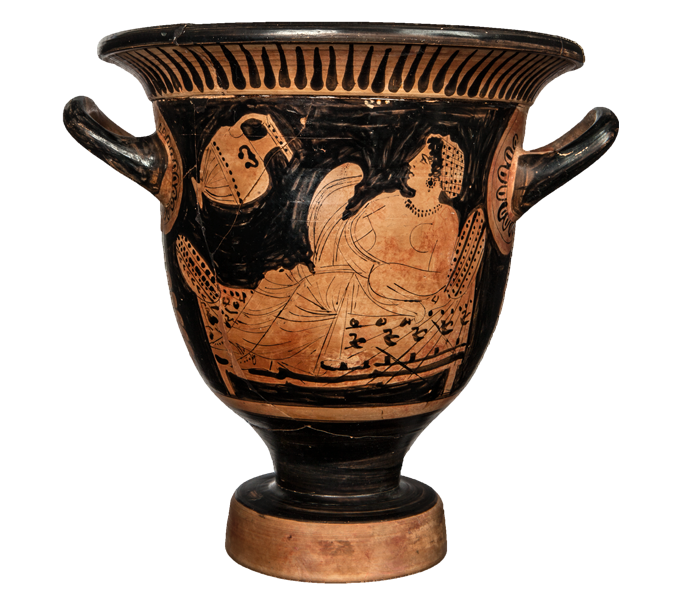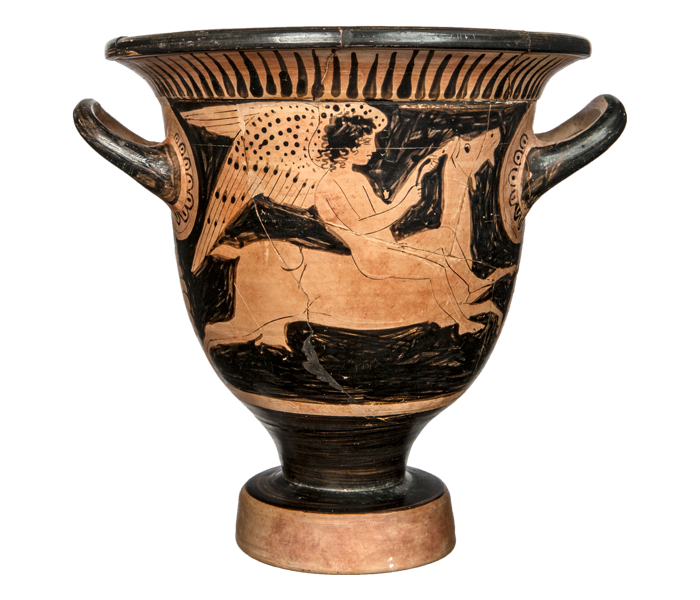Exhibit of the month
The shower of love …
Boeotian red-figure bell krater
National Archaeological Museum
Collection of Vases and Minor Arts, inv. no. A 12593
Attributed to the Workshop of the Painter of the Great Athenian Kantharos
Provenance: Unknown (Papademos Collection)
Dimensions: H.: 23 cm, Diam. of rim: 21.6 cm, Diam. of foot: 10 cm
Date: circa 430 BC
Display location: Vase Collection, Room 56, Showcase 141.
According to the myth, Akrisios, the king of Argos, imprisoned his daughter Danae in a subterranean chamber reinforced with bronze so as not to give birth to the child that, based on an oracle he had received, would kill him and take over his throne. Nevertheless, Zeus, fallen in love with the beautiful princess, entered her cell from the roof in the form of golden rain that fell into her womb and impregnated her. The child that was born from their union was Perseus, founder of Mycenae.
The Boeotian vase depicts Danae reclining on a couch with a cushion at either end and richly decorated tapestries, gently raising her head in anticipation and excitement to look at the golden rain (suggested by dots of added white color) falling on her breast. She is dressed in a pleated himation that leaves the upper part of her torso bare, a hairnet adorned with dots, double necklace, intricate earrings and closed laced shoes. High up in the field is a large hydria, presumably made of metal. The bareness of the maiden’s breasts, unknown in the Attic examples that illustrate the myth, alludes to her “marriage” with the father of the gods, while the opulent jewels and the shoes that may be identified with the nymphides (Hesychius, s.v. nymphides: bridal shoes) also refer to the adornment of the bride-to-be.
Moreover, the appearance of the god in the form of golden rain recalls the nuptial bath of brides prior to their weddings, which is also symbolized by the hydria that hangs on the wall of the chamber. The eagerness of the maiden to receive the god is underlined by her raised right arm towards the rain, but is also denoted by the kolpos (fold) of her himation over her abdomen, a word that had manifold significations in antiquity as well (kolpos may also mean womb).
The pervasive eroticism of the scene is reinforced by the presence of the young naked and curly-haired Eros on side B of the vase. The boy serves as a bridge between the heavenly and the earthly realm, accompanying the maiden in her transition to sexual maturity, but as he rides on a goat, namely a tamed animal, he concurrently symbolizes her taming with marriage. So, Danae on this vase, becomes an exemplary bride, a model for every maiden who is about to cross the threshold of marriage.
Even though the circumstances of the krater’s discovery are unknown, its use in symposia as a vessel for mixing wine and water is dismissed due to its small size. The nuptial theme with which it is decorated advocates the view that it was possibly given to a bride as a gift or was placed as an emblematic grave good inside the grave of a young woman who passed away prematurely without relishing the joys of marriage and motherhood. In this latter case, the tragic character of the early death of the maiden would be further underscored by the reminder that the ideal marriage which is depicted on the krater takes place έν τυμβήρει θαλάμω (in a grave-like chamber) (Sophocles, Antigone, l. 946).
Dr Christina Avronidaki
Bibliography:
Ch. Avronidaki, An Assortment of Bridal Images on a Boeotian Red-figure Pyxis from the Workshop of the Painter of the Great Athenian Kantharos,”” στο S. Schierup.
V. Sabetai (επιμ.), The Regional Production of Red-figure Pottery: Greece, Magna Graecia and Etruria (Gosta Enbom Monographs 4), Aarhus 2014, 99 αρ. 6, με την παλαιότερη βιβλιογραφία.
LIMC III, 1986, λ. Danae, no. 8 (J.-J. Maffre).
LIMC III, 1986, λ. Eros, no. 246 (A. Hermary).
Ι.Θ. Κακριδής (επιμ.), Ελληνική Μυθολογία, Αθήνα 1986.




